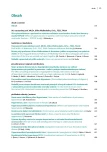Neuro-cardiology or cardio-neurology – a new specialization of the future?
Authors:
Petr Widimský 1; Ivana Štětkářová 2
Authors‘ workplace:
Kardiocentrum 3. LF UK a FN Královské Vinohrady, Praha
1; Neurologická klinika 3. LF UK a FN Královské Vinohrady, Praha
2
Published in:
Vnitř Lék 2015; 61(5): 484-486
Category:
Reviews
Overview
Acute ischemic stroke is a catastrophic cardiovascular disease with frequent cardiac causes and cerebral consequences, thus the close cooperation between neurologists and cardiologists is necessary for the optimal patient management. Furthermore, recent randomized trials demonstrated, that catheter-based thrombectomy (CBT) is the most effective treatment for properly selected patients. Interventional cardiology with its widespread non-stop services for acute myocardial infarction can fill the existing gaps in coverage of population needs with neurointerventional services. Thus, a new future medical subspecialization may emerge: neurocardiology or cardioneurology.
Key words:
acute stroke – cardiology – cardioneurology – neurocardiology – neurointervention – neurology – thrombectomy
Sources
1. Sacks D, Black CM, Cognard C et al. American Society of Acute Ischemic Stroke; Canadian Interventional Radiology Society; Cardiovascular and Interventional Radiological Society of Europe; Society for Cardiovascular Angiography and Interventions; Society of Interventional Radiology; Society of NeuroInterventional Surgery; European Society of Minimally Invasive Neurological Therapy; Society of Vascular and Interventional Neurology. Multisociety consensus quality improvement guidelines for intraarterial catheter-directed treatment of acute ischemic stroke, from the American Society of Neuroradiology, Canadian Interventional Radiology Association, Cardiovascular and Interventional Radiological Society of Europe, Society for Cardiovascular Angiography and Interventions, Society of Interventional Radiology, Society of NeuroInterventional Surgery, European Society of Minimally Invasive Neurological Therapy, and Society of Vascular and Interventional Neurology. Catheter Cardiovasc Interv 2013; 82(2): E52-E68.
2. Emberson J, Lees KR, Lyden P et al. Stroke Thrombolysis Trialists’ Collaborative Group. Effect of treatment delay, age, and stroke severity on the effects of intravenous thrombolysis with alteplase for acute ischaemic stroke: a meta-analysis of individual patient data from randomised trials. Lancet 2014; 384(9958): 1929–1935.
3. Emberson J, Lees KR, Lyden P et al. Stroke Thrombolysis Trialists‘ Collaborative Group.Effect of treatment delay, age, and stroke severity on the effects of intravenous thrombolysis with alteplase for acute ischaemic stroke: a meta-analysis of individual patient data from randomised trials. Lancet. 2014; 384(9958):1929–1935.
4. Tung CE, Su D, Turakhia MP et al. Diagnostic Yield of Extended Cardiac Patch Monitoring in Patients with Stroke or TIA. Front Neurol 2015; 5: 266. Dostupné z DOI: <http://dx.doi.org/10.3389/fneur.2014.00266>.
5. Hopkins LN, Holmes DR Jr, Ramee S. Turf wars and silos-joined at the hip: what can be done? Catheter Cardiovasc Interv 2007; 69(5): 764–765.
6. Widimský P, Kožnar B, Štětkářová I. Moderní léčba akutních iktů: příklad multidisciplinární spolupráce. Vnitř Lék 2014; 60(12): 1086–1089.
Labels
Diabetology Endocrinology Internal medicineArticle was published in
Internal Medicine

2015 Issue 5
Most read in this issue
- Hyperosmolar hyperglycemic state
- Hemocoagulation – New views on the old cascade
- The role of uric acid and allopurinol therapy in cardiovascular disease
- Hypertension in females
